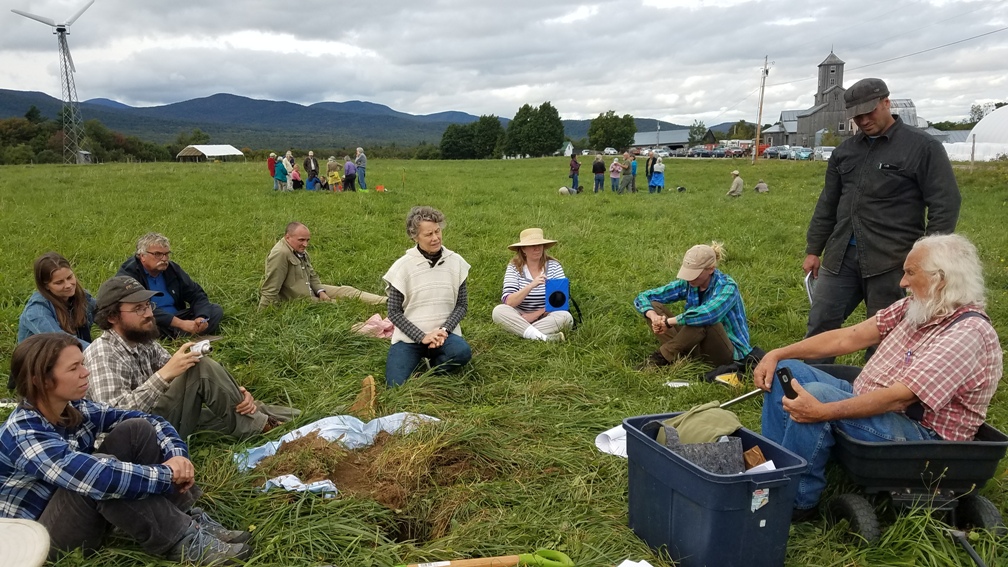Thanks to hosts Anne and Jack Lazor, their beautiful farm, workers, and lovely cows, and all 50+ attendees at the Land Listeners workshop on Sept. 20, 2018 at Butterworks Farm near Westfield, Vermont. Thanks to facilitators Cat Buxton and Didi Pershouse, and to the Grazing Lands Coalition which helped Soil Carbon Coalition to sponsor it.

photo by Cat Buxton
For the land managers who attended, I wholeheartedly recommend Sarah Flack's book The Art and Science of Grazing: How Grass Farmers Can Create Sustainable Systems for Healthy Animals and Farm Ecosystems, and other resources available at her website. She's got a basic section on pasture monitoring, and it's a good guide.
Three starter metrics I would also advocate for most producers include:
- Length of green season from remote sensing (example from Champlain Basin here, and feel free to share this and other resources on our site), and I may be able to get numbers on request if you send me farm boundary.
- Water infiltration (example here), soil cover, visual soil assessments.
- Production per acre per unit of limiting input. For example, pounds of meat or milk per acre per unit of P or N imported as feed or fertilizer. It can be any combination of product or input.
Forms for items 2 and 3 can be found on atlasbiowork.com; info and instructions here.
We ended the workshop with a question, what might be the enabling conditions for growing soil health and watershed function in Vermont? This is a tough deep question and most of you didn't have time to digest or think it over. As mentioned, it is a different question than "How to create soil health" or what's the best practice -- both of which almost inevitably devolve into conflict and competition.
Here's my transcription, with some rearrangement for flow:
Butterworks Farm, Land Listeners event. What might be the enabling conditions for growing soil health and watershed function in Vermont?
Education, connecting people with food they eat. It starts with kids, with community and school gardens. Instead of my grandchildren being indoors in school for 4 days a week and outdoors for 1, flip it. The public has to latch onto taking care of soil, that it's important for health and food.
Educating people: living soil is not dirty. Soil is part of the commons. Humanity, humility, and humus. A pot of parsley on the patio. Disconnecting food and health from the market economy. Education, building a supportive community, a critical mass. Building the social mycelium in a way that mimics the ecosystem.
Work with early adopters, put education out there, a cultural shift happening. Carry a snot-and-slime pack with me. Make it fun. When we pull out the flour vs bread demo, people say, for god's sake I've just seen that lots of times. Share Didi's book. Share with audiences. Get out there and be active, get off our butts.
Resist the fast food culture, which makes us lose a sense of space and time, lose our human sense of place. Paying attention to the literal ground. Learning the importance of soil from people who work with it on a daily basis. Reforging connections between people who grow food, and people who eat it. Getting paid more to make a living with growing food. Kindle the appreciation.
Move our conversations from "how president is so terrible" to what we need and want. Top down stuff is really important, like running a serious campaign for public office. Vote, and change where you are.
Setting an example for my own children, friends, and family. Try doing it with my own hands. Asking the right questions. Paying attention to reality, and learning what to pay attention to. How to ask the right questions? Reframing, not as simply good vs. bad.
We can and should measure ecosystem function. We need that as feedback and to hire farmers. Enough people realizing that it's possible to grow the soil carbon sponge, that it's practical, and it's important to me. This is no longer controversial, we can do these things. Count the externalized costs.
Postscript
If these are enabling conditions for growing the soil carbon sponge in Vermont, what in turn are the enabling conditions for these, and how do we foster them?
Recent Posts
Archive
Categories
- Events (2)
- policy and framing (22)
- ruminations (3)
Tags
- atlas (2)
Authors
- Peter Donovan (136)
- Didi Pershouse (3)